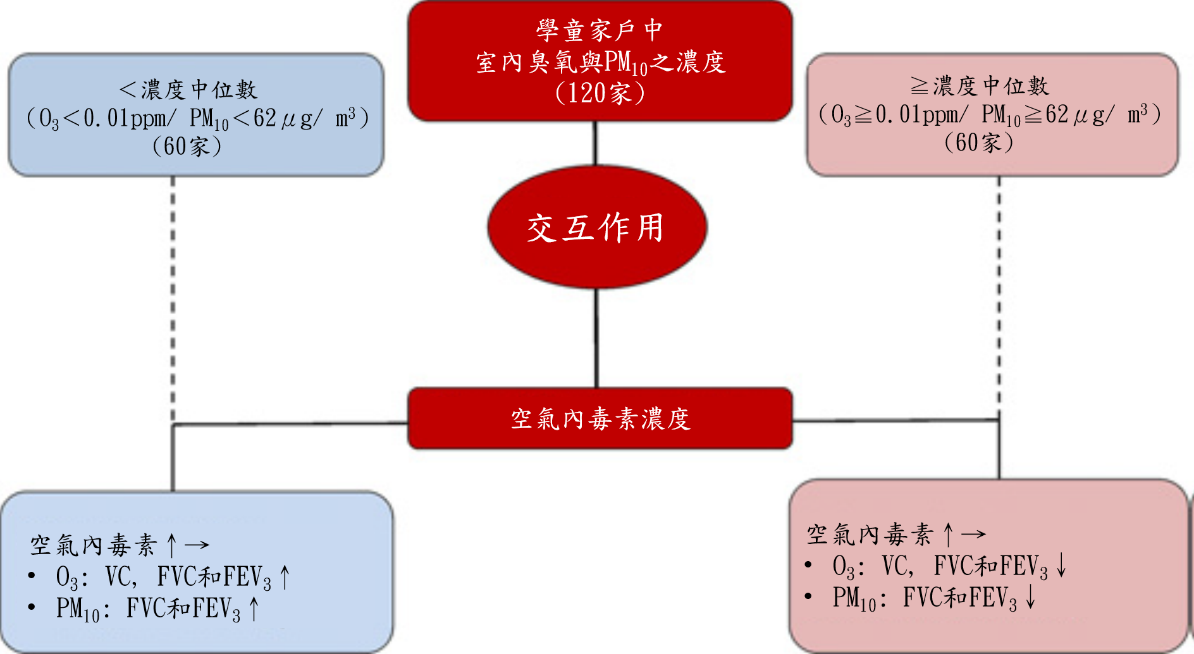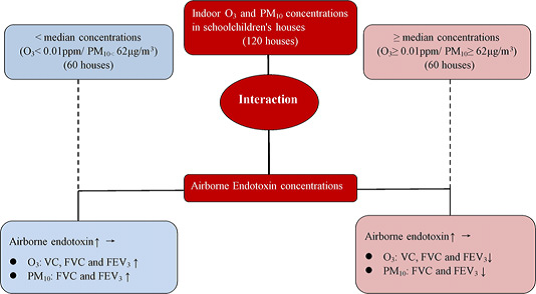內毒素為革蘭氏陰性菌細胞壁的成分,過去研究指出,居家室內空氣中內毒素會讓氣喘孩童氣喘症狀惡化,然目前尚不清楚家戶空氣污染物對空氣中內毒素與學童肺功能之間影響。本校公共衛生學系陳培詩主任研究團隊長期致力於探討室內空氣品質與孩童健康研究。研究團隊與美國德克薩斯大學休士頓醫學中心合作,針對高雄國小學童居家,探討室內空氣污染物是否會影響室內空氣中內毒素與學童肺功能之間的關係。論文近期刊登於《整體環境科學》(Science of the Total Environment) 其研究成果,對於公共衛生領域有重大研究貢獻,更進一步了解在氧和PM10濃度較高的環境,空氣內毒素越高,發現學童肺功能越不好,未來可藉由控制室內空氣中內毒素,達到保護呼吸道健康之目的。
陳培詩主任指出,內毒素為革蘭氏陰性菌細胞壁的成分,在空氣中,即使細菌死亡,從破碎之細胞壁釋出之內毒素,仍然有造成氣喘惡化之疑慮,然而,到目前為止,內毒素對過敏與肺功能影響結果並不一致,有動物實驗指出,空氣汙染物會影響內毒素對老鼠健康的關係,因此,本團隊與美國德克薩斯大學休士頓醫學中心合作,在高雄國小學童家中實際評估室內空氣污染物,例如:一氧化碳,二氧化碳,二氧化氮,二氧化硫,臭氧,
PM10,PM2.5對室內空氣中內毒素與學童肺功能關係的影響。本研究團隊發現學童居家空氣中臭氧和PM10的濃度均會顯著的影響空氣內毒素與學童肺功能之間的關係。 在臭氧和PM10濃度較高的家庭(臭氧≥0.01 ppm或PM10≥62μg/ m3),空氣內毒素越高,發現學童肺功能越不好,但是在臭氧和PM10濃度較低的家戶(臭氧<0.01 ppm或PM10<62μg/ m3)的家庭中,就沒有此現象,本研究提供了過去研究結果不一致的原因,內毒素對健康的影響,其實還跟室內的臭氧與PM10有關。本研究經費由高雄市衛生局,高雄醫學大學及科技部教育部計畫共同支持。
圖形摘要
本研究團隊發現學童居家空氣中臭氧和PM10的濃度均會顯著的影響空氣內毒素與學童肺功能之間的關係。 在臭氧和PM10濃度較高的家庭(臭氧≥0.01 ppm或PM10≥62μg/ m3),空氣內毒素越高,發現學童肺功能越不好,但是在臭氧和PM10濃度較低的家戶(臭氧<0.01 ppm或PM10<62μg/ m3)的家庭中,就沒有此現象

本校主要研究者之簡介:
陳培詩 研究員
研究聯繫Email:
pschen@kmu.edu.tw
期刊出處:
Science
of the Total Environment 705 (2020) 135810
研究全文下載:
https://www.sciencedirect.com/science/article/pii/S004896971935805X
Endotoxin is the constituent of the
cell wall of gram-negative bacteria that initiates the inflammatory response. Previous
studies showed consistent results that airborne endotoxin exposure may increase
the risk of respiratory symptoms in asthmatic children.
Moreover, previous studies displayed that the air pollutants- nitrogen dioxide
(NO2) and nicotine may modify the association between
airborne endotoxin and asthma outcome (acute visit, symptoms, etc.) and airway
inflammation (the fractional concentration of exhaled nitric oxide) in asthmatic
children.
So far, limited studies
have explored the effects of interactions between airborne endotoxin and air pollutants.
The team led by Pei-Shih Chen, the Chair of Public Health of Kaohsiung Medical University,
evaluated whether indoor air pollutants in a heavy industrial city, including
NO2, PM, the carbon monoxide (CO), carbon dioxide (CO2), sulfur dioxide (SO2),
and ozone (O3), can modify the association between indoor airborne endotoxin
and lung function. 120 elementary school-age children in Kaohsiung City, Taiwan
was recruited. Airborne endotoxin and air pollutants were collected for 24
hours in living rooms while schoolchildren’s lung function was measured. The
modification of air pollutants on the relationship between airborne endotoxin
and children’s lung function was estimated after adjusting the gender, age,
height, weight, and case-control status. The team in collaborating with
Epidemiology, Human Genetics, and Environmental Sciences, School of Public
Health, University of Texas Health Science Center at Houston, TX, United States,
found that household O3 and PM can modify the association between household
airborne endotoxin and lung functions. Our findings suggest that the
combination of higher concentrations of O3 or PM10 exposure and concomitant
indoor airborne endotoxin exposure may affect schoolchildren’s lung function in
a heavy industrial city. These findings also highlight the importance of
understanding the complexity of indoor exposures and their effects on lung
functions to develop effective approaches to environmental control. The results
have been published in the journal Science of the Total Environment .
Graphical
Abstract
Our
findings suggest that the combination of higher concentrations of O3 or PM10
exposure and concomitant indoor airborne endotoxin exposure may affect
schoolchildren’s lung function in a heavy industrial city.

Main
researcher Intro.
Researcher
Pei-Shih Chen
Author
Email
pschen@kmu.edu.tw
Paper
cited from:
Science
of the Total Environment 705 (2020) 135810
Research
Paper available online on website
https://www.sciencedirect.com/science/article/pii/S004896971935805X

